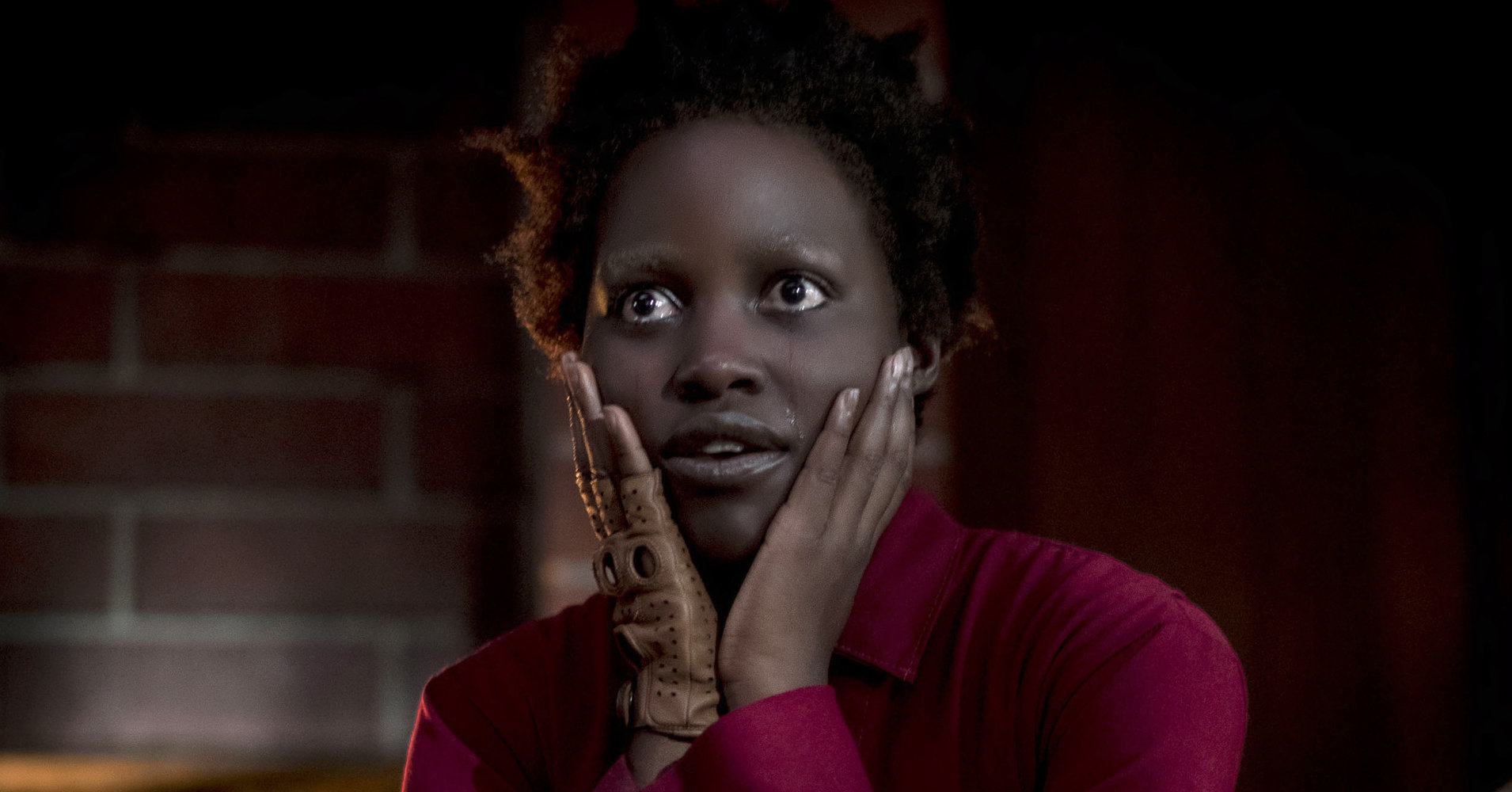[ad_1]
Warning: “Us” spoilers below.
When Lupita Nyong’o enters “Us” for the first time, it’s as Adelaide Wilson, a California mom taking a beach vacation with her family. She seems more or less normal, grooving to “I Got 5 on It” in the car, munching on strawberries at their inherited summer home, bantering with her playful husband (Winston Duke) and disciplining her kids (Shahadi Wright Joseph and Evan Alex). Nothing out of the ordinary there. But before long a second Nyong’o appears in the dead of night. That one’s named Red, and she behaves very differently, like a cross between a robot and a bug-eyed Charlie Chaplin. Armed with large gold scissors, she’s menacing and maniacal. Anything but normal.
To differentiate between Adelaide and Red ― beyond, that is, Red’s crimson jumpsuits and Robert F. Kennedy Jr.-inspired croak ― Nyong’o worked closely with Madeline Hollander, a choreographer whose specialty combines ballet and uncanny conceptual movement. Hollander spent four months collaborating with Nyong’o and the rest of the cast to forge their evil subterranean doppelgängers, central to the plot of Jordan Peele’s buzzy “Get Out” follow-up. After that, Hollander was on the set throughout the roughly two-month shoot. Finding inspiration in everything from Pac-Man and “Death Becomes Her” to “The Addams Family” and “The Exorcist,” Hollander designed a precise batch of motions that links each double to his or her aboveground counterpart.
To hear Hollander describe the process is fascinating. Over the phone on Sunday, right as “Us” was winding down its massive opening weekend, Hollander walked me through the work she did with Peele, Nyong’o, Elisabeth Moss and others to create these villainous twins, as well as the bleak “Nutcracker” snippet from the film’s finale. Along the way, I heard about cockroaches, whack-a-mole, Buster Keaton and all sorts of disparate elements that helped make “Us” so eerie.
How did “Us” enter your life?
“Us” entered my life because Ian Cooper, who is one of the producers and a friend and an artist, was helping with the script. There’s a scene from “The Nutcracker” that’s been written into the script for the last dance sequence. He immediately calls me and he’s like, “You’ve done ‘The Nutcracker’ 10,000 times. Can we talk about this?” There are some parallels between the story of “The Nutcracker” and “Us.” They’re all about this character going into this underworld of candy, and how dark that story is. So I immediately flew out to meet Jordan [Peele] and talk about this last scene. I knew that he needed a version that was going to be the grand pas de deux ballet version, and then he needed something that would be the complete opposite of that, that would be the tethered version of the same variation.
So I went in with a million ideas of how to kind of invert and distort this very classical, iconic variation that is usually a pas de deux between the Sugarplum and Cavalier and kind of fuse them together into this one frenetic role and take it into the underpass world. I created a parallel dance that would happen simultaneously but kind of be like as if the ballet dancer on top was almost puppeteering the other dancer so that she would be kind of slamming against the walls but still in the tutu and trying to kind of continue the dance.

You were brought on specifically for the “Nutcracker” portion, then your work on the movie grew from there?
Yeah, it was like the second we started talking, we were on the same page. I understood what he wanted. We immediately went through the script, and I started giving motion notes for each of the characters so that we could develop Red and what that type of character she would be if she was an ex-dancer, and how the alternate Shahadi [Wright Joseph, who plays Nyong’o’s daughter, Zora] should look and feel, and pulling up references.
And then halfway through the meeting, he brought in the storyboard artist and we started mapping out and blocking the scenes. When I read a script, I see it kind of spatially. So we started mapping out that final sequence of how Lupita was kind of doing this Pac-Man, cockroach, balancing-a-book-on-her-head movement sequence with the storyboard artist, and then brought in the composer. It was almost like we just started production the second I got there.
How did you start developing the non-“Nutcracker” portions?
While reading the script, I created a list of motion notes for each of the characters and brought in all of these reference videos of other types of movement that I felt, through Jordan’s writing and the direction in the script, seemed very fitting.
So you’re working with eight different characters: two families of four, each with a double.
And then stunt doubles. And I was also consulting with the stunt coordinator, Mark Vanselow, on all of the action scenes to also make sure that those types of movements actually corresponded with the characters’ backgrounds.
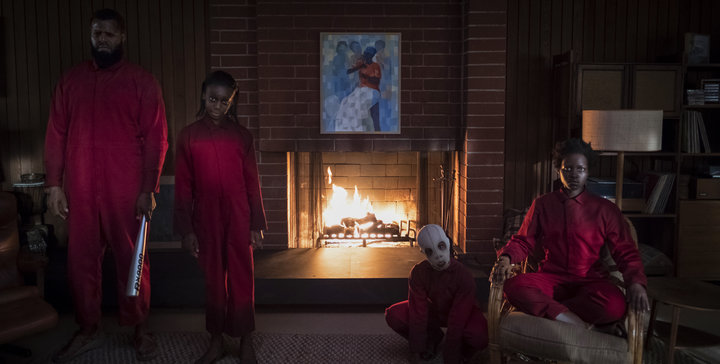
That way they’re not all of a sudden snapping out of character while murdering someone with a pair of scissors.
Exactly, which is something that happens so often in film where some clumsy character just all of a sudden turns into a pro samurai fighter, and you’re like, “Where did that come from?” For me, that takes me out of the film because I’m like, “I don’t believe that that person is doing that.”
An ex-ballet dancer is more likely to use her legs and flexibility in a fight than her upper body. A ballet dancer isn’t somebody who’s going to punch someone in the face ― they’re going to kick someone in the face. When they kick someone, they’re going to be turned out, not turned in, which is where your toes are pointed outwards instead of pigeon-toed. And so a lot of it was also making sure, in these fight sequences or even just in the movement, there’s continuity.
The scene where Lupita is handcuffed to the coffee table and reaching for the fire poker, I was like, “OK, well, I would never reach for that with my hand. I can’t reach it.” I pick up things with my toes all the time. A dancer would pick that up with her toe and very articulately lift it out of its holder and bring it into her hand, which is what she ended up doing. Those are details that maybe are not going to get picked up as choreography, per se.
Let’s talk specifically about Lupita’s doppelgänger. The second she enters the house, we can sense her physicality. I see it as these robotic, almost metronome-driven movements. How did you develop Red, and then how did you and Lupita finesse her together?
We made mood boards for both of the characters and started talking about what it means to be an ex-ballet dancer and what that entails and the personality of this other creature. The first thing that needed to happen was Lupita really wanted to understand what it felt like to be a ballet dancer, and even just to get the feeling of what it’s like to feel sore after a ballet class. One of the main features is the neck and the spine, where there’s a very specific ballet neck that’s kind of a way of holding your spine very straight. That’s just something that, when you’ve done ballet all your life, you have and you can recognize instantly. So we started training together.
Then I set her up with one of my trainers who is an incredible ballet trainer in New York, Fabrice Herrault. Every morning, she was doing a three-hour private with Fabrice. And then we would meet together and go through the script and practice everything from gestures that would align with the lines she was speaking to the way she was sitting, how you would sit at the beach, how you would stand up, sit down, how you’d get in and out of a car, how you might stretch your arm after a long drive, ways that you would stand, not stand.
So that was developing Adelaide’s character, and then the other character was trying to figure out what’s the opposite. How would you make something graceful really creepy? For me, it’s all about anticipation. That other character is always three steps ahead, so it’s almost like there’s no acceleration ever. It’s always a constant rate, the way that she moves, kind of using a Pac-Man path. She knows how to get there, and she knows exactly how to time it to get there.
It’s very rhythmic, and it’s very 90-degree angles. She’s never moving things around for her to get there faster, or she doesn’t try and take the fastest route, doing diagonals, because she can take her time. She knows she has the power. She definitely has agency, and it’s her territory, down in the underpass. She’s only ever lived there, so it’s the feeling of being able to navigate that whole space without her eyes open. So we did spend a lot of time rehearsing where she was just kind of practicing moving backwards so that she started using her back more than her front. That was kind of our warmup, actually, to move throughout a space backwards for enough time that it kind of expands your peripheral vision and you start to use your back as your set of eyes. You just develop a very expanded self-awareness.
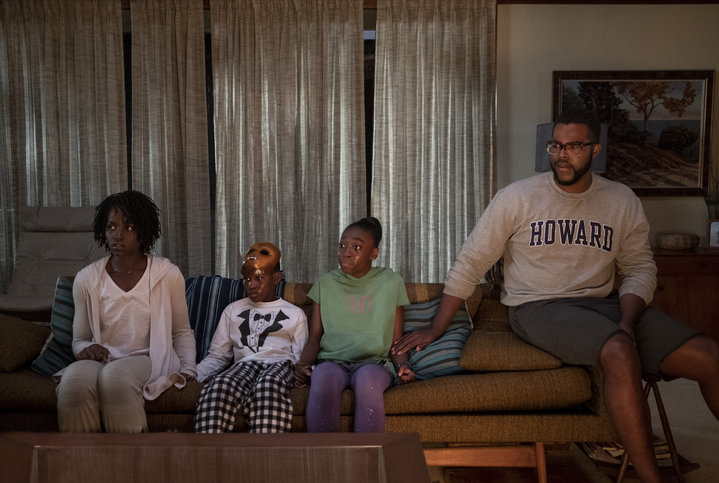
The other characters don’t have as obvious a backstory as Adelaide, so you couldn’t build off a certain hook for them. Pluto, the little boy’s doppelgänger, for example, has this spidery, creepy-crawly thing going on. Is there an interconnectedness to them as a family?
The other characters in the Wilson family were articulated by Jordan in the script, about who they were and how they fit together as a composition. I feel like it is still very conceptual in terms of the roles they all played. I was able to talk to Jordan about what the inverse of those personalities would be ― not just on a personality level, but on a very physical level.
For example, there’s always some sort of tension between the two characters. Zora’s alternate is always leaning forward and always on her toes. She almost has this feeling of longing toward Shahadi, which comes out in this glare that is both haunting and disturbing but also kind of like she’s in love with her. There’s this type of tension where she just wants to be close to her.
Whereas Justin [Nyong’o’s son, played by Evan Alex] and his alternate keep on engaging in this mirroring game, which you see in the closet, where they’re both tricksters. They realize that their connection is that they’re going to play this game where they’re mirroring each other’s hand. That mirroring game is something that you do in improv classes and some dance warmups. Something that is kind of mundane got taken to the next level in that sequence with the car burning, where that game came back and Evan’s character [could say], “I know how this works. I know how to get out of this.” That’s his double’s weakness. And then his double was something that Jordan had been very clear from the beginning of wanting to be really creaturely. Somewhere between a spider meets a dog. There were 10 different animals that got thrown in there.
Had you seen what the doppelgängers’ costumes would look like? I assume the jumpsuits would inform your choices for their movements.
Yes, from the beginning. And I was getting these amazing test images, and I was like, “What type of material is that? How does it bend at the knee?” ― very technical costuming questions.
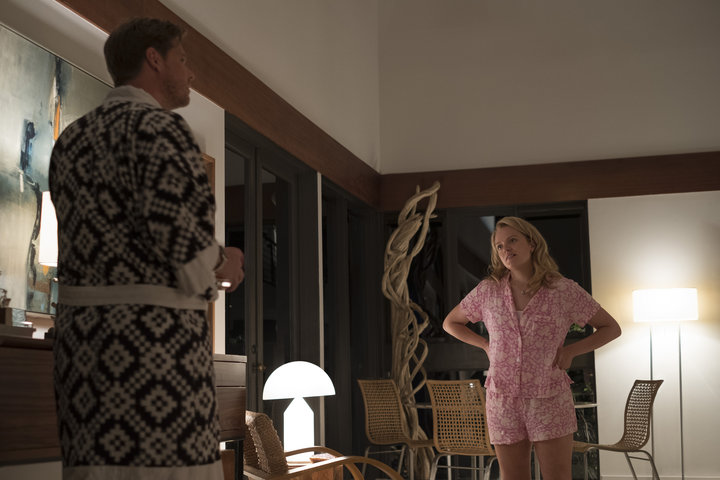
Let’s shift to the other family. I’m specifically interested in Elisabeth Moss’ character because that transition is wonderful. I can’t think of a better word than just “crazed.”
Elisabeth was the only actor that wasn’t on set constantly. I actually worked with her the least, and most of my contribution to that was really going through all the movement direction with Jordan in the script and developing the character through these references, and just talking through it over and over again. And when she came onto set, she was extremely busy. I think she was shooting 10 other things. It was really just her genius ability to do the scene 10 times, and it was a lot of improv and a lot of notes from Jordan. It was very immediate, and not something that was rehearsed. It was something that I think is very much her doing.
What were some of the references you used for the film?
Everything from Michael Jackson’s “Thriller” movements to “Death Becomes Her” to crawling down the stairs backwards in “The Exorcist.” They’re all over the place. We had a different mood board of references for each character and for each double.
And with twin girls, were you specifically going for an hommage to “The Shining”?
Yes. That was definitely there from the get-go. And then the roles got kind of extended. These are characters that are going to be doing cartwheels and handstands on the beach, so their tethered characters would be inverting the cartwheels and doing these really bizarre backflips. There’s that scene with the massacre in the house where one of the twins comes down from a handstand in the closet. You see her upside down first, and then she comes up. It’s really about inverting, making sure every single shot gets linked back to some other moment in the film.
For the big underground tableau that’s set at the Santa Cruz boardwalk, there are a lot of elements that blend together that look both disconcerting and oddly harmonious all at once. Can you talk a little bit about arranging those vignettes and the way that the camera kind of snakes through them at the end of the movie?
That was an incredible scene. Essentially that underpass was supposed to be the doppelgänger of the Santa Cruz boardwalk. We created these sections in the underpass that would double as what this ride [aboveground] is, so here’s the rollercoaster, here’s the whirligig, here’s the whack-a-mole, and arranging that so it actually was kind of like a map of how the boardwalk is set up. And then [we would look] at the whack-a-mole and be like, “All right, what would the underpass version of this be, the tethered version?” So instead of hitting the mole on the head, I have these characters punching the tiles on the wall, as if kind of going crazy, punching their own first into the wall.
And then there’s all of the pedestrians. If you look at a normal scene on a boardwalk, you see everyone has their own walk to begin with and their nuanced way of picking up something or how they’re interacting with the other person. So I looked at what that was and then worked with each of the people in the underpass scene and developed their own walk. I individually went through and was like, “All right, show me your walk.” And I was like, “Let’s exaggerate this times 10. Let’s have you turn out this leg, or turn in this leg. Let’s arch your back 10 more degrees.” Everyone got their own signature walk that just was completely off: leaning too far in one direction, or someone that looks extremely lost, or is bent over in a way like they’re picking something up but they’re never going to stand back up. And that set everyone in motion, and we practiced with them so that it just becomes normalized.
So it wasn’t them doing some weird choreography. It was more like them getting used to a new way of walking. The extent of that underpass scene was so incredible in terms of how many people were involved and how many different parallels and nuanced moments and details. Obviously a lot has to be edited out because it’s not going to be a four-hour film.
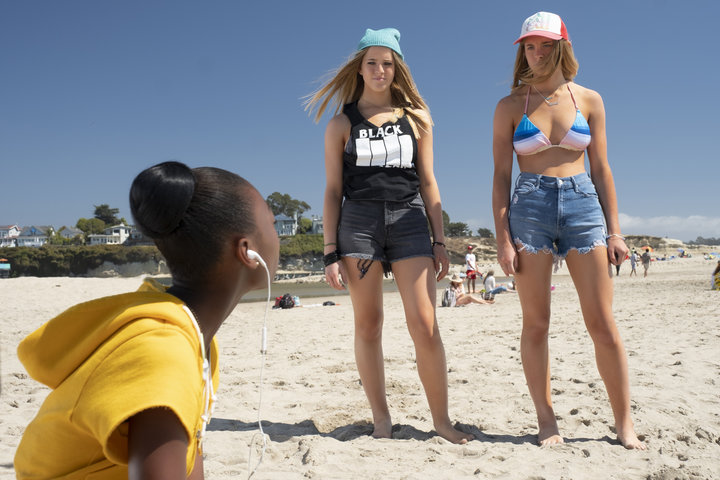
Is there an aspect ― a scene or a gesture, maybe ― that was the hardest to pull together?
The things that were the hardest were more logistical. Let’s say, for example, the underpass or the beach scenes. I’m used to working one-on-one with people or with groups of 20 and having direct access in getting to do rehearsal. And all of a sudden you’re working with 99 extras, and everyone is on a beach and it’s really hard to hear. So there’s a lot of me sprinting around trying to direct multiple scenes at the same time. That was kind of impossible, so I ended up selecting these movement leaders. I picked some people that I knew had either dance training or were able to kind of pick up on my movement direction and worked with them prior to the scenes. That way I could set a scene in motion and let them all be responsible for 10 people or 20 people.
When you saw the movie for the first time, what surprised you the most?
When I first saw it, it was the first time I had seen it with the actual score. I’d always seen little snippets of the score, or I’ve seen versions where parts of a score were there and parts weren’t, because things weren’t finished yet. For me, the score really was the chilling glue that tied everything together. It made it 10 times scarier, and it really looped everything together. It congealed conceptually and allowed your brain to make those connections between the characters and the rhythm and the movement.
Is it an unusual experience for you to work on choreography and movement that’s informed by music and not have a more intimate relationship with the music?
Yeah. But I was able to work with [composer] Michael Abels the entire time, who is a genius. He was going to be developing the music for the dance scene at the end. And this is before they put in “I Got 5 on It.” We have hundreds of emails going back and forth where I’m sending him clips of rehearsal, and he’s like, “How about this?” We have this very intense dialogue.
You mentioned a few references you brought to the table in developing the actors’ movement. Is there anything we’d be surprised to know you referenced?
I was pulling a lot from contemporary. Merce Cunningham, Charlie Chaplin and Buster Keaton. It goes from a sequence of something or a way that something is set, or the type of pace, to literally a gesture. “The Addams Family” and the posture of Wednesday Adams. And then also referencing a lot of my own work. I would take clips from my own choreographic practice and kind of Frankenstein them together ― specifically pieces called “Arena,” “65 Degrees” and “Drill” that had particularly uncanny or creepy moments. I would stitch them together and match that with one scene from “The Nutcracker” and then Meryl Streep falling down the stairs in “Death Becomes Her.” A very Frankenstein-y process.
This interview has been edited and condensed.
[ad_2]
Source link

